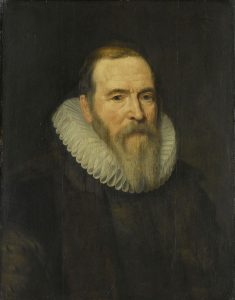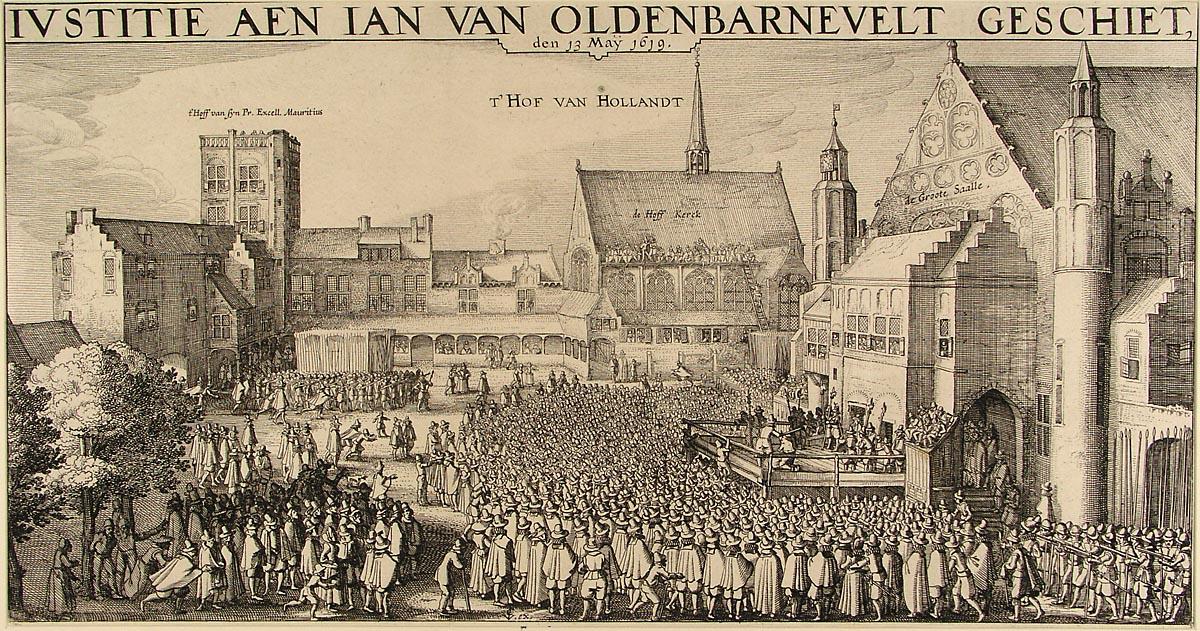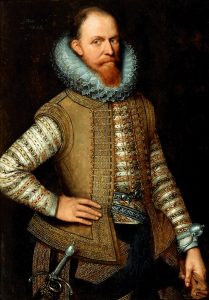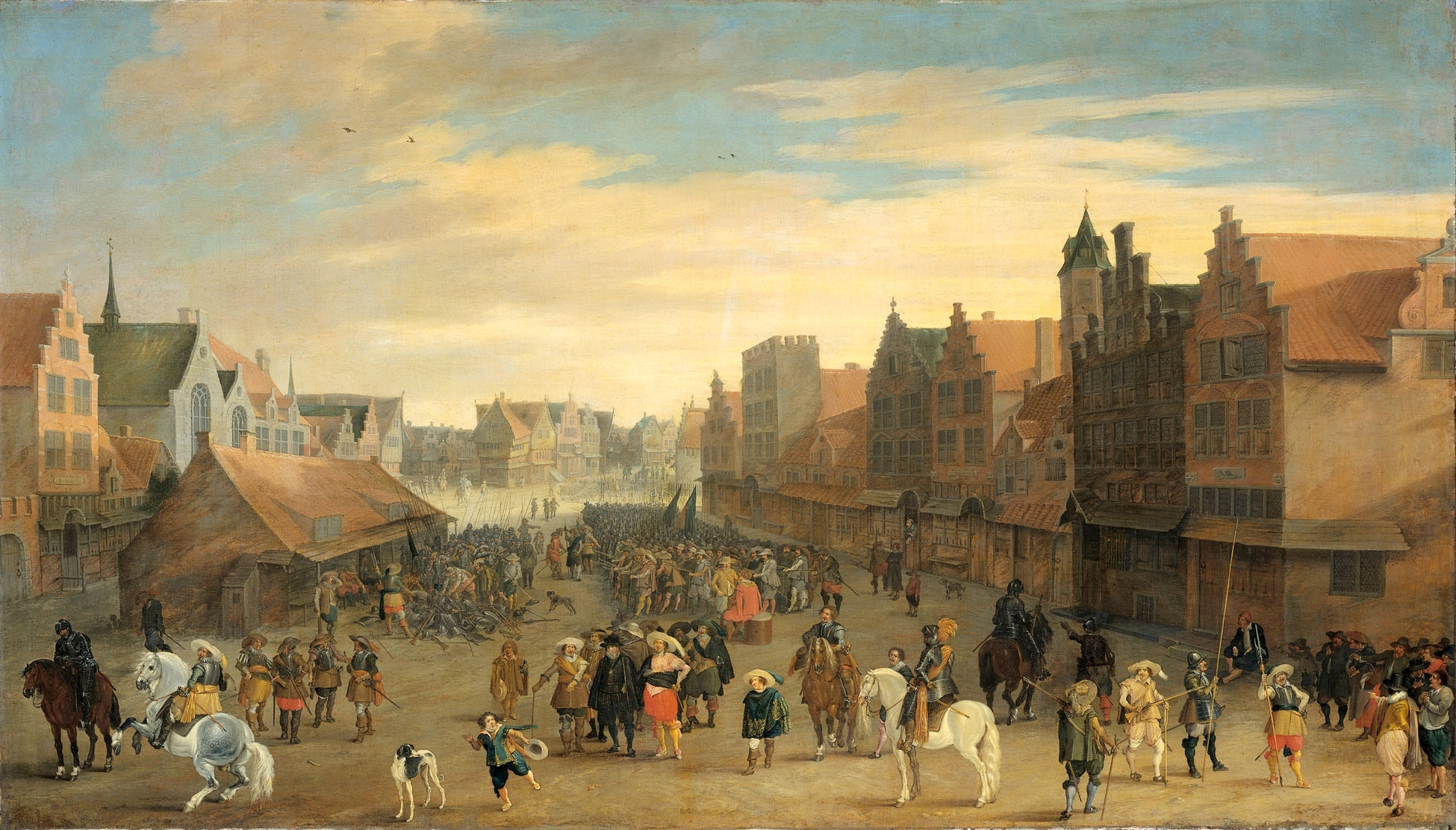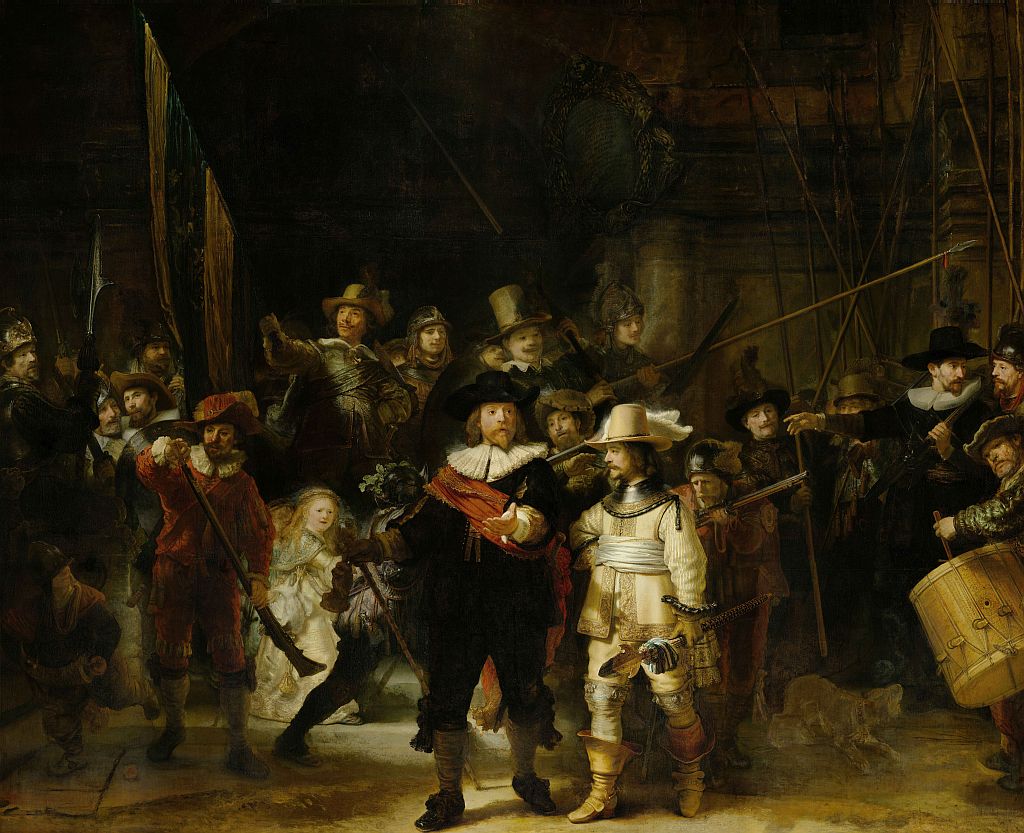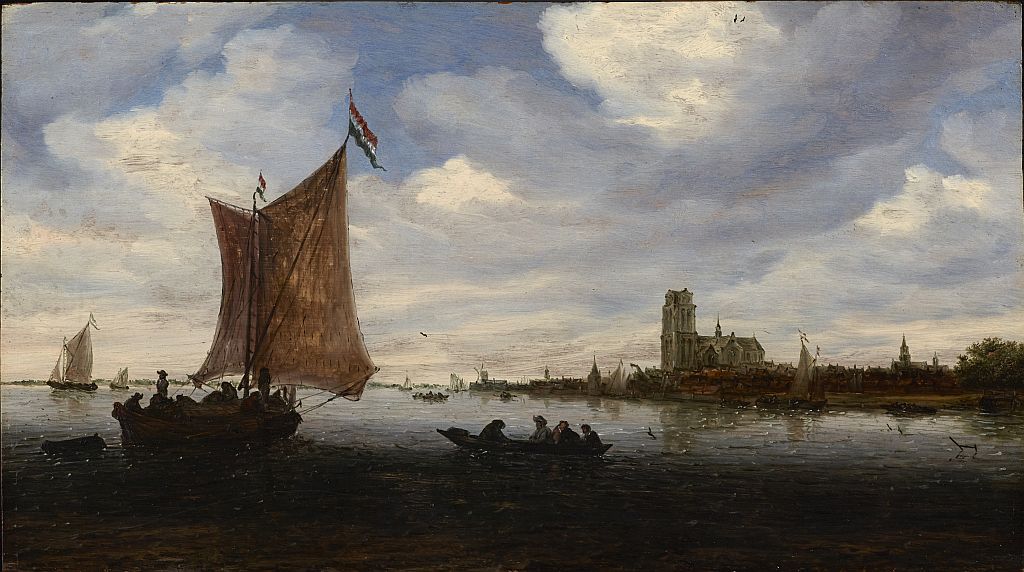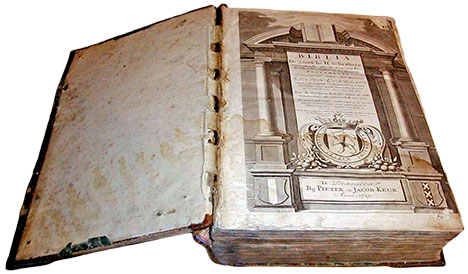The Northern Netherlands started to become “Dutch”
2. Small philosophers in the Netherlands
In the Netherlands, one distinguishes, next to the greater – (and others), also two “a bit smaller” philosophers. They are called “small” because they were twitching into an infighting. Unlike the great philosophers, they had no positive influence on each other but a negative one. So it did not enrich the spiritual life but, on the contrary, they splitted it. That split, which also grew among their followers, was the reason for convening the Synod of Dordrecht.
2.1 Jacobus Arminius (Oudewater 1559 – Leiden, 1609)
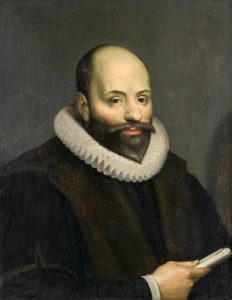 Jacobus Arminius, a Latinization form of Jacob Hermans (son), was a preacher and also a theologian during the beginning of the Eighty Years War. In the year 1588 Arminius was confirmed as pastor of the Old Church in Amsterdam. In 1590 He married Lijsbet Reæl (1569-1648) and became the brother in law of Laurens Reæl, who was one of the founders of the V.O.C.Because of his liberal interpretation of predestination (the divine chosenness) Arminius was since 1591 very badly attacked by his fellow minister Peter Plancius (theologian, astronomer, cartographer). In 1593 they put their quarrel to an end after a very thorough dialogue. The views of Arminius led to theological current called Arminianism, which questioned some of the Calvinism thesis and caused a great theological dispute, which took place in the Netherlands in the late 16th and 17th centuries. Finally Arminianism was rejected by Reformed Protestants and lost to orthodox Calvinism. Portrait painted by Bailly David, 1620
Jacobus Arminius, a Latinization form of Jacob Hermans (son), was a preacher and also a theologian during the beginning of the Eighty Years War. In the year 1588 Arminius was confirmed as pastor of the Old Church in Amsterdam. In 1590 He married Lijsbet Reæl (1569-1648) and became the brother in law of Laurens Reæl, who was one of the founders of the V.O.C.Because of his liberal interpretation of predestination (the divine chosenness) Arminius was since 1591 very badly attacked by his fellow minister Peter Plancius (theologian, astronomer, cartographer). In 1593 they put their quarrel to an end after a very thorough dialogue. The views of Arminius led to theological current called Arminianism, which questioned some of the Calvinism thesis and caused a great theological dispute, which took place in the Netherlands in the late 16th and 17th centuries. Finally Arminianism was rejected by Reformed Protestants and lost to orthodox Calvinism. Portrait painted by Bailly David, 1620
2.2. Franciscus Gomarus (Bruges 1563 – Groningen, 1641)
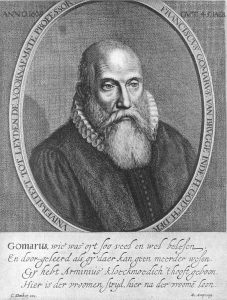 Franciscus Gomarus (actually François Gomær), was from 1594 to 1611 a professor of religion at the University of Leiden, but later he became best known as the great leader of the Counter-Remonstrants. The quarrel with his colleague Jacobus Arminius, the leader of the Remonstrants, mainly centered on the question of the extent of predestination and if “God acts” depend upon the doings of man – Gomarus thought not, Arminius thought yes. Gomarus said: God acts are “sovereign”, so they do not depend on what people do.
Franciscus Gomarus (actually François Gomær), was from 1594 to 1611 a professor of religion at the University of Leiden, but later he became best known as the great leader of the Counter-Remonstrants. The quarrel with his colleague Jacobus Arminius, the leader of the Remonstrants, mainly centered on the question of the extent of predestination and if “God acts” depend upon the doings of man – Gomarus thought not, Arminius thought yes. Gomarus said: God acts are “sovereign”, so they do not depend on what people do.
2.3 The discord
In 1603 Arminius became the professor of theology at the Leiden University what aroused vehement protest of his colleague professor Francis Gomarus. Almost immediately, in 1604, both professors came into a collision with each other. Their conflict concerned on the doctrine of justification and the adjoining doctrine of predestination.
For Arminius the faith of a man was to a certain extent provided for a forgiving judgment in which god man “justifices”, that is “declares righteous”. Faith alone is not sufficient but a necessary condition for God’s forgiveness.
For Gomarus the role of faith was here purely instrumental: it was the acceptance awakened by the spirit by a man of God justifying judgment. If God forgiveness in all respects to the faith precedes (as Gomarus thought), it is a logical next step to thereby underline: this verdict and the decision by God to bring a man to the faith, does not suddenly come up, but it forms his eternal election.
If one (with Arminius) underlines the choice for faith, then the “eternal counsel” of God also depends on its human choice. Thus, the doctrine of justification becomes naturally the same as predestination. That this is indeed the shift that took place in the debate between Arminians and Gomarists.
The Amsterdam minister Plancius interfered in the struggle and sided with Gomarus. Soon after the religious disagreement grew into a national political struggle in the northern Netherlands. Johan van Oldenbarnevelt, the secretary of the States of Holland, took the side of Arminius but Prince Maurice (governor of Holland and therefore the commander of the “state” forces) was angry because of the 12-year-chease fire which was wanted by Barneveld and therefore he sided for Gomarus. Finally van Oldenbarnevelt was arrested and executed on May 13th, 1619, and the dispute was continued by the Synod of Dordrecht, in favor of the very orthodox Counter-Remonstrants. The execution of the then already old, Johan van Barneveld is still a very painful scar in the history of the Netherlands. It was the first (and last) time that a Dutch government put someone to death because of a conviction. Portrait painted by Michiel van Mierevelt.
Decapitation of Johan van Oldenbarnevelt / painting by Claes Jansz Visscher
The theological conflict between Arminius and Gomarus brought a deep aversion to the States of Holland which, certainly during the 80 Years War, did not want a “sharp” discussion. So in 1607 they formed a committee that could settle the conflict. Thus the States of Holland were forced to agree to the twelve-year truce (while they were on the winning side in that war) to solve first this serious division in the provinces, caused by the hardliners in the churches.
To stop the conflict Arminius and Gomarus were summoned to appear in the Court of Holland and in the States of Holland. This solved nothing however. In 1609 the States of Holland again organized meetings to bring theologians together, unhappily Jacobus Arminius had to leave these sessions because of illness, and soon died at about the age of fifty in Leiden in October of that year and was buried in the Pieterskerk. So very unfortunately the States of Holland lost every opportunity to resolve this religious conflict peacefully.
After 1618 Gomarus was (until his death) “banned” from Leiden as became a professor at the University of Groningen (so paid by the states, but far away from Leiden!). He lies buried in the Martini Church in Groningen, along his wife.
2.4. The result: The first split in the “old” Low German church (1610)
In January 1610 a group of 44 ‘reformed’ ministers arrived to Gouda and formulated their objections to the doctrine of “their” Dutch Reformed Church. Those objections, related to the teachings of the Heidelberg Catechism and the Creed in particular, showed the conflict between the “free will” of the people and the decision to “salvation or damnation” by God (predestination). They also objected to some Calvin ideas. These views were recorded in 1610 in a “defense” or: “remonstrance”. This defense is today known as the “Five Articles” of the remonstrants.
The core of the religious conflict:
The Remonstrants were (and are) against the confessional formulas (which defines how to interpret the Bible). Becouse they gave the confession drafted by people a “sacred” status as well as the “Word of God” (the Bible). Which – according to the Erasmian – tradition is absolutely unthinkable. (It is also a serious Calvinistic objection against the Catholic Church, the holy “word”, for example of the Pope). They also had questions about the predestination. The most severe forms of this doctrine assumes that only those souls are eternally saved (thus get to heaven) that were elected by the omniscient God before the sinfall (Doctrine of predestination). Arminanism does not (emotionally intense) accept that. The activity of man would certainly (also) count.
The Arminian ideas are based on the “Dutch Formation“, so to the ideas of “five great philosophers“. They stressed: an inner Christianity, the values of the love for ones neighbours, the personal freedom and tolerance. They were called the moderates (rekkelijken). So the dissenters, the strict ones, wanted a “Reformation”.
Concepts: Remonstrant – Contra-Remonstrant:
The defense letter (old language: remonstrance) was a part of a religious dispute over the doctrine of predestination, send by the followers of Arminius to the States of Holland. That explains why the followers of Arminius (Arminians) thereafter are called: “Remonstrants”. Opponents of that application, so the followers of Francis Gomarus (the Gomerianen), are the so called “anti-Remonstrants”.
As was said above, Prince Maurits, (the governor of Holland, among others), chose Gomarus while Johan van Oldenbarnevelt (Secretary of the States of Holland) chose Arminius. Three main factors have played a role in this conflict:
2.5 Prince Maurits (Dillenburg, 1567 – The Hague, 1625)
I. Religion:
Maurice was raised in a very (Germanic) Calvinistic way by his uncle Jan van Nassau. That upbringing was marked at the time by the ruling principle “cuius regio, eius religio” (means: the ruler – given authority by God – determines the country’s religion). The church at that time was not an independent institution (there was no separation of church and state!) The government also determined the governance of the Church. The remonstrance was therefore not sent to an ecclesiastical institution, but to the States-General. Portrait by Michiel Jansz van Mierevelt.
Van Oldenbarnevelt was as an administrator, opposed to the strictly trained Maurice, in favor of the dissents within the church. The coup must to be seen therefore, in the light of the principle “cuius regio”. Maurice’s authority would warrant a Calvinist unity church (a not united church could result in a not united country). Furthermore, Johan van Oldenbarnevelt wanted an alliance with catholic France and a truce with catholic Spain what was viewed suspiciously. Maurits suspected a trick of the enemy in the truce to give the Catholic belief better chances.
II. Finances:
Johan van Oldenbarnevelt was well aware of the financial situation of the Republic and he knew how expensive the civil war was. He was sure that a successful war could only be possible if the financial foundations were solid. The downside was that he considered money as more important than life of a soldier. Maurice was the opposite. He was a soldier so he cared much more of the lives of his men than of money. Besides, he knew that a poorly paid army would not follow its leaders. This opposition had already led to more insoluble conflicts, but the Twelve Year Truce (which was van Oldenbarnevelt (emergency) business because of the financial situation of the Republic) led to a great schisms for Maurits, because he realized that the Spanish enemy was at that moment at its weakest.
III. characters:
Maurice was pronounced patient and careful. He carefully examined the situation before every tactical step and evaluated them afterwards. He rather chose a small but determined military gain than a riskier tremendous win. Johan van Oldenbarnevelt however was someone who used to think further ahead and also wanted to take greater risks. Until the Battle of Nieuwpoort those characters fitted to each other well. Maurice saw however the value of his careful way confirmed in the battle of Nieuwpoort. Van Oldenbarnevelt took too much risk. From that moment he did not trust him anymore.
Scrapping waardgelders, at the Neude in Utrecht, by Prince Maurits, July 31, 1618 (Sections waardgelders in the background).
The waardgelders (mercenaries):
In August 1617 the States of Holland took a “Sharp Resolution”. This resolution gave the cities in Holland the ability to install independently, but at the expense of the states of Holland, “waardgelders” (mercenaries) to prevent more local unrest. In practice, this was seen as directed against the “night watchmen” and the militias which mostly consisted of contra Remonstrants.
The “Nachtwacht” (night watchmen) by Rembrandt van Rhijn
Cities forming their own armies (mercenaries) ment undermining the authority of Prince Maurits, the captain general of the military forces of all provinces. This was absolute unacceptable to the prince. He knew van Oldenbarnevelt was responsible for this situation. The pensionary, Rombout Hogerbeets, Gillis Leedenberch, Hugo Grotius, and the pastor Uytenbogaard went into emergency meetings. The prince went to Utrecht to discard the newly appointed waardgelders and, not least, he demanded there would be a church synod and there should be churches made available to the Counter-Remonstrants. Also degelates from Holland traveled to Utrecht. On July 31, 1618, the waardgelders were quietly dismissed and replaced by existing, cheaper indigenous soldiers. The counter-Remonstrants were given the Buurkerk and the Arminarians got the cathedral at their disposal. But that was not in ratio to the sizes of the groups so a few days later they exchanged the churches (in good harmony!).
2.6 The Synod of Dordrecht (1618 – 1619)
After the States of Holland (together with the lawyers of the Court of Holland), had made two attempts to bring Gomerus and Armenius in a comprehensive dialogue, to learn each other’s thoughts and give respect to each other, they concluded that this was not a successful way. So they decided that churches had to pronounce on this doctrinal issue in a general synod. This had to be done before the end of the Twelve Years’ Truce. The churches responded that were not financially able, the States of Holland answered they would pay all the costs. After that, finally, all decided to have that synod.
View of Dordrecht, Salomon van Ruysdaal, 1660
In 1618 – 1619 the Synod of Dordrecht was held. High on the agenda was a ruling in the dispute between the Remonstrants and Counter-Remonstrants. The positions against Remonstrants appear in five points, known as the “Canons of Dort.” They are an official part of the three confessions of the Dutch Hervormde- and the Dutch Reformed churches. Internationally, they are called “the five points of Calvinism”. After that Remonstrants had to abandon the “Protestant Church”.
2.7 Results:
Without going further into the religious controversies it can be said that the Synod had, for the Netherlands, also five culturally very deep consequences:
1619 The Canons of Dort were established . So the Dutch Calvinism was well defined. International people still speaks of the “five points of Calvinism”.
1637 The Bible was, very closely from the Greek and Hebrew source texts, translated into Dutch. Due to the widespread use of these “States-Bible” the Dutch language was gradually standardized.
1773 All psalms were in that same language put to music (so in all the churches all the people themselves went singing the same texts. (Revised and completed in 1773). See Psalms.
1773 All these translations were provided by the University of Leiden on behalf of a government that has not interfered (but bore all the costs). The actual beginning of the separation of church and state! (The beginning of the end of the “cuius regio, eius religio” rule in the Netherlands) .
1998 On the basis, of the for the bible translation gathered vocabulary was a complete dictionary of the Netherlands language (all words , written after about 1550 to about 1927) possible. This is the most comprehensive dictionary in the world. It was completed in 1998. (The medieval dictionary ( 1150-1550 ) was already finished).
Han Tiggelaar
January 30, 2016

